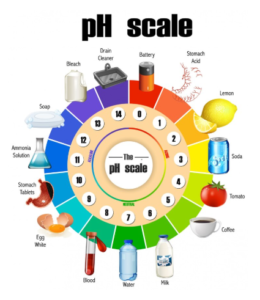The term “pH balance” strength sounds like a complex interaction, but it’s an important concept that touches everything from our forms to the soil in our gardens. This guide will explore pH balance, its importance in numerous aspects of life, and how to uphold optimal pH heights for better health and well-being.
The Science Behind pH Balance
pH stands for “potential of hydrogen” and is measured on a scale from 0 to 14. This scale helps us understand how acidic or alkaline (basic) a substance is:
- 0-6.9: Acidic
- 7: Neutral
- 7.1-14: Alkaline (or primary)
Each number on the pH scale represents a tenfold change in acidity or alkalinity. For example, a pH of 5 is ten times more acidic than a pH of 6 and a hundred times more acidic than a pH of 7.

pH Balance in the Human Body
Blood pH Balance
Your blood maintains a slightly alkaline pH between 7.35 and 7.45. This narrow range is crucial for:
- Proper enzyme function
- Oxygen delivery to tissues
- Cell membrane stability
- Nutrient absorption
- Overall metabolic health
The body has several systems in place to maintain this delicate balance, including:
- Respiratory system
- Renal system (kidneys)
- Buffer systems in the blood
- Bone mineral stores
Skin pH Balance
The skin’s acid mantle, with an optimal pH between 4.7 and 5.75, serves as a protective barrier against:
- Harmful bacteria
- Environmental toxins
- Moisture loss
- Premature aging
Read more: Understanding the Causes of Hair Fall: A Comprehensive Guide
Signs of pH Imbalance
Acidic pH Symptoms
- Fatigue
- Frequent infections
- Headaches
- Muscle pain
- Digestive issues
- Dry skin
- Brittle nails
Alkaline pH Symptoms
- Nausea
- Hand tremors
- Muscle twitching
- Confusion
- Numbness
- Reduced appetite
Maintaining Optimal pH Balance Through Diet
Acid-Forming Foods
While these foods aren’t necessarily unhealthy, they should be consumed in moderation:
- Red meat
- Processed foods
- Refined grains
- Sugar
- Coffee
- Alcohol
- Artificial sweeteners
Alkaline-Forming Foods
Include more of these foods in your diet:
- Leafy green vegetables
- Fresh fruits
- Root vegetables
- Nuts and seeds
- Legumes
- Herbs and spices
- Cold-pressed oils
pH Balance in Different Body Systems
Digestive System
The digestive system maintains different pH levels throughout:
- Mouth: 6.5-7.5
- Stomach: 1.5-3.5
- Small intestine: 6.0-7.4
- Large intestine: 5.5-7.0
Urinary System
- Normal urine pH: 4.5-8.0
- The optimal range for preventing kidney stones is 6.0-6.5
Environmental pH Balance
Soil pH Balance
Understanding soil pH is crucial for:
- Plant growth and health
- Nutrient Availability
- Microorganism activity
- Crop yield
- Garden maintenance
Most plants prefer a soil pH between 6.0 and 7.0, though some species have specific preferences:
- Acid-loving plants (pH 4.5-5.5):
- Blueberries
- Azaleas
- Rhododendrons
- Alkaline-loving plants (pH 7.0-8.0):
- Lavender
- Clematis
- Baby’s breath
Water pH Balance
Different water sources have varying pH levels:
- Pure water: 7.0
- Tap water: 6.5-8.5 (regulated)
- Swimming pools: 7.2-7.8
- Natural lakes: 6.5-8.5
Testing and Monitoring pH Levels
At-Home Testing Methods
- pH Test Strips
- Quick and convenient
- Available for various applications
- Relatively accurate
- Digital pH Meters
- More precise measurements
- Useful for regular monitoring
- Requires calibration
- Litmus Paper
- Simple acid/base indication
- Less precise but easy to use
- Cost-effective
Natural Ways to Balance pH
Lifestyle Changes
- Hydration
- Drink adequate water daily
- Consider alkaline water
- Add lemon to water (although acidic, it has an alkalizing effect)
- Exercise
- Regular physical activity
- Proper breathing techniques
- Stress management
- Sleep
- Maintain a regular sleep schedule
- Get 7-9 hours nightly
- Create an optimal sleep environment
Supplements for pH Balance
Always consult healthcare providers before starting supplements:
- Alkalizing minerals
- Magnesium
- Potassium
- Calcium
- Zinc
- Green supplements
- Chlorella
- Spirulina
- Wheatgrass
- Green juice powders
Professional pH Balance Solutions
Medical Treatments
When pH imbalance becomes severe:
- Intravenous fluids
- Electrolyte replacement
- Oxygen therapy
- Medications to correct imbalances
Alternative Therapies
- Acupuncture
- Herbal medicine
- Aromatherapy
- Massage therapy
pH Balance in Industry
Applications
- Agriculture
- Soil treatment
- Crop management
- Hydroponics
- Manufacturing
- Food production
- Cosmetics
- Cleaning products
- Water Treatment
- Municipal water systems
- Swimming pools
- Industrial processes
Common Myths About pH Balance
Debunking Misconceptions
- “All acidic foods are harmful.”
- False: Many healthy foods are acidic
- Balance is key
- Consider the overall dietary pattern
- “Alkaline water cures diseases”
- Limited scientific evidence
- May support hydration
- Not a miracle cure
- “You can dramatically change your blood pH through diet.”
- The body tightly regulates blood pH
- Diet affects other systems more readily
- Extreme pH changes require medical attention
Conclusion
Sympathetic and upholding pH balance is a fundamental feature of overall health. While the body has urbane mechanisms for maintaining good pH levels, supporting these systems through diet, lifestyle, and suitable interventions can contribute to the best health and energy. Remember that individual needs vary, and working with healthcare professionals can help develop a personalized approach to upholding your body’s pH balance.
Focusing on evidence-based practices and upholding a holistic approach to health can support your body’s natural pH-balancing mechanisms and promote overall wellness. Continue to stay well-informed about current research and best practices while listening to your body’s unique needs and responses to different interventions.
